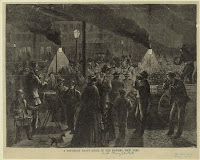In honor of National Poetry Month, and in anticipation of tonight's Tenement Talk with poet Stephen Wolf, we're posting some of our favorite poems from his New York-centric collection I Speak of the City.By Allen Ginsberg (1926 - 1997)

...Rugged and raw situations, and having accepted them as part of your
home ground, then some spark of sympathy or compassion could take place.
You are not in a hurry to leave such a place immediately. You would like to
face the facts, realities of that particular world...
Upstairs Jenny crashed her car & became a living corpse, Jake
sold grass, the white-bearded potbelly leprechaun silent
climbed their staircase
Ex-janitor John from Poland averted his eyes, cheeks flushed with
vodka, wine who knew what
as he left his groundfloor flat, refusing to speak to the inhabitant
of Apt. 24
who'd put his boyfriend in Bellevue, calling the police, while the
artistic Buddhist composer
on sixth floor lay spaced out feet swollen with water, dying slowly
of aids over a year -
The Chinese teacher cleaned & cooked in Apt. 23 for the
homosexual poet who pined for his gymnast
thighs & buttocks - downstairs th' old hippie flower girl gell
drunk over the banister, smashed her jaw -
her son despite moderate fame cheated rocknroll money,
twenty thousand people in stadiums
cheering his tattoed skinhead murderous Hare Krishna
vegetarian drum lyrics -
Mary born in the building rested on her cane, heavy legged with
heart failure on the second landin, no more able
to vacation in Caracas & Dublin - the Russian landlady's
husband from concentration camp disappeared again -
nobody mentioned he'd died -
tenants took over her building for hot water, she couldn't add
rent & pay taxes, wore a long coat hot days
alone & thin on the street carrying groceries to her crooked
apartment silent-
One poet highschool teacher fell dead mysterious heart
dysrhythmia, konked over
in his mother's Brooklyn apartment, his first baby girl a year old,
wife stoical a few days -
their growling noisy little dog had to go, the baby cried -
Meanwhile the upstairs apartment meth head shot cocaine &
yowled up and down
East 12th Street, kicked out of Christine's Eatery till police
cornered him, 'top a hot iron steamhole
near Stuyvesant Town Avenue A telephone booth calling his deaf
mother - sirens speed the way to Bellevue-
past whispering grass crack salesmen jittering in circles on East
10th Street's
southwest corner where art yuppies come out of the overpriced
Japanese Sushi Bar - & they poured salt into potato soup
heart failure vats at KK's Polish restaurant
-Garbage piled up, nonbiodegradable plastic bags emptied by
diabetic sidewalk homeless
looking for returnable bottles recycled dolls radios half-eaten
hamburgers - thrown away Danish -
On 13th Street the notary public sat in his dingy storefront,
driver's lessons & tax returns prepared on old metal desks -
Sunnysides crisped in butter, fries & sugary donuts passed over
the luncheonette counter next door -
The Hispanic lady yelled at the rude African-American behind
the Post Office window
"I waited all week my welfare check you sent me notice I was
here yesterday
I want to see the supervisor bitch do't insult me refusing to
look in -"
Closed eyes of Puerto Rican wino lips cracked skin red
stretched out
on the pavement, naphtha backdoor open for the Korean family
dry cleaners at the 14th Street corner -
Con Ed workmen drilled all year to bust electric pipes 6 feet deep
in brown dirt
so cars bottlenecked wait minutes to pass the M14 bus stopped
midroad, heavy dressed senior citizens step down in
red rubble
with Reduced Fare Program cards got from grey city Aging
Department officers downtown up the second flight by
elevators don't work -
News comes on the radio, they bombed Baghdad and the Garden
of Eden again?
A million starve in Sudan, mountains of eats stacked on docks,
local hangs & U.N.'s trembling bureaucratic officers sweat
near the equator arguing over
wheat piles shoved by bulldozers - Swedish doctors ran out of
medicine - The Pakistani taxi driver
says Salman Rushdie must die, insulting the Prophet in fictions -
"No that wasn't my opinion, just a character talking like in a
poem no judgement -"
"Not till the sun rejects you do I," so give you a quarter by the
Catholic church 14th St. you stand half drunk
waving a plastic glass, flush-faced, live with your mother a
wounded look on your lips, eyes squinting,
receding lower jaw sometimes you dry out in Bellevue, most days
cadging dollars for sweet wine
by the corner where Plump Blindman shifts from foot to foot
showing his white cane, rattling coins in a white paper cup
some weeks
where girding the subway entrance construction saw-horses
painted orange guard steps underground - And across the
street the NYCE bank machine cubicle door sign reads
Not in Operation as taxis bump on potholes asphalt mounded at
the cross road when red lights change green
& I'm on my way uptown to get a CAT scan liver biopsy, visit the
cardiologist,
account for high blood pressure, kidneystones, diabtes, misty
eyes & dysesthesia -
feeling lack in feet soles, inside ankles, small of back, phallus
head, anus -
Old age sickness death again come round in the wink of an eye -
High school youth the inside skin of my thighs was silken smooth
tho nobody touched me there back then -
Across town the velvet poet takes Darvon N, Valium nightly
sleeps all day kicking methadone
between brick walls sixth floor in a room cluttered with collages
& gold dot paper scraps covered
with words: "The whole point seems to be the idea of giving
away the giver."





































